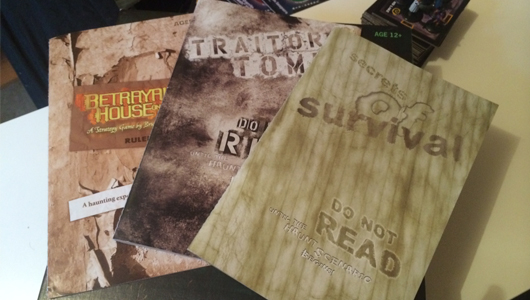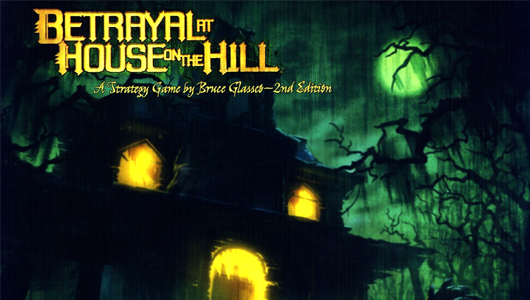Designer: Bruce Glassco
• Publisher: Avalon Hill
• Number of Players: 3-6
• Playing Time: 30-120 min
[/box]
 Betrayal at House on the Hill is a great example of a cooperative-competitive board game. It is filled with that wonderful schlock quality of the best B-movie horrors and allows you to create your own haunted mansion, unleash and kill all types of deadly monsters while trying to avoid numerous traps and unpleasant events. The game is divided into two phases – Explorations Phase, the cooperative part of the game, and the Haunt Phase where one of the players will be turned a traitor to compete with the other characters, now called the heroes, for their survival.
Betrayal at House on the Hill is a great example of a cooperative-competitive board game. It is filled with that wonderful schlock quality of the best B-movie horrors and allows you to create your own haunted mansion, unleash and kill all types of deadly monsters while trying to avoid numerous traps and unpleasant events. The game is divided into two phases – Explorations Phase, the cooperative part of the game, and the Haunt Phase where one of the players will be turned a traitor to compete with the other characters, now called the heroes, for their survival.
 In the first phase, the players explore the House by randomly laying down room tiles for corresponding floors – basement, ground or upper floors. Every game you play will be different because the arrangement of the House will never be the same, especially since some rooms can be place on more than one floor.
Betrayal excels at keeping the feeling of ‘something bad is going to happen!’ throughout. Even a simple act of flipping over a card creates an anticipation of bad things coming. This is because almost every room has one of the three types of symbols. The single symbol that is good, Item, is useful but also very rare. I have played several games without picking up a single item card for my character. This teaches you quickly not to expect any help from the House, especially since the other two symbols are more common and are also very bad for you. One of them, Events, tests the strength of your character. This is where the levels of your characters’ traits become important. By using a mixture of skill (your character stats) and luck (rolling dice), you character must attempt to survive whatever horror the House conjures. If you do this particularly well, you might even get rewarded with a stat boost for your character. Omens, the last type, misleads you into thinking they are good by giving players items or even companions, such as a dog, but they will eventually lead to the worst thing of all – the Haunt.
In the first phase, the players explore the House by randomly laying down room tiles for corresponding floors – basement, ground or upper floors. Every game you play will be different because the arrangement of the House will never be the same, especially since some rooms can be place on more than one floor.
Betrayal excels at keeping the feeling of ‘something bad is going to happen!’ throughout. Even a simple act of flipping over a card creates an anticipation of bad things coming. This is because almost every room has one of the three types of symbols. The single symbol that is good, Item, is useful but also very rare. I have played several games without picking up a single item card for my character. This teaches you quickly not to expect any help from the House, especially since the other two symbols are more common and are also very bad for you. One of them, Events, tests the strength of your character. This is where the levels of your characters’ traits become important. By using a mixture of skill (your character stats) and luck (rolling dice), you character must attempt to survive whatever horror the House conjures. If you do this particularly well, you might even get rewarded with a stat boost for your character. Omens, the last type, misleads you into thinking they are good by giving players items or even companions, such as a dog, but they will eventually lead to the worst thing of all – the Haunt.
 The Haunt Phase can be triggered at any point in the game. Every time an Omen card is picked up, the revealer must roll six dice and if he or she rolls a number lower than a total number of Omen cards already revealed, then the Haunt begins. Therefore the Haunt will probably not start at the beginning of the game, when there are only few Omen cards on the table, as it is very unlikely to roll six zeroes. Although my friends have found out that with my dice rolling luck, I can beat any odds and have learnt to expect the worst when I pick up an Omen card.
Here is where Betrayal truly shines in its unique approach to tradition cooperative-competitive gameplay. Until this point all players have been working together, trying to survive against the attacks of the House. However, after the Haunt, one of them turns into a traitor set on killing the heroes in the most gruesome way possible. If this sounds like an unfair fight for one lonely traitor faced with at least 2 (maximum 5) other characters – don’t you worry! The traitor has some very nasty friends joining shortly. The traitor receives a Traitor’s Tome that describes the specific Haunt and the powers the traitor now possesses. While the heroes get the Survival Guide and decide on their best survival tactic together. There are 50 different Haunt scenarios with their own specific win conditions for the traitor and the heroes. This, together with varying layout of the House, means that you can return to the game again and again because there will always be something new happening.
In this review I have tried to talk as little as possible about the specifics of the cards, room tiles or the Haunts because reading the descriptions (out loud and in a dramatic voice!) for the first time is a great fun in itself. The cards are a great mixture of the funny-horrible, the rooms are beautifully detailed, the Haunts come with back stories and every character has their own story which can be found at the back of the Traitor’s Tome. If inventing stories for characters is something you love doing, then you have everything you need to go crazy creative. If not, then the information and art give enough to set the scene and get you in the mood for some horror-fun.
The Haunt Phase can be triggered at any point in the game. Every time an Omen card is picked up, the revealer must roll six dice and if he or she rolls a number lower than a total number of Omen cards already revealed, then the Haunt begins. Therefore the Haunt will probably not start at the beginning of the game, when there are only few Omen cards on the table, as it is very unlikely to roll six zeroes. Although my friends have found out that with my dice rolling luck, I can beat any odds and have learnt to expect the worst when I pick up an Omen card.
Here is where Betrayal truly shines in its unique approach to tradition cooperative-competitive gameplay. Until this point all players have been working together, trying to survive against the attacks of the House. However, after the Haunt, one of them turns into a traitor set on killing the heroes in the most gruesome way possible. If this sounds like an unfair fight for one lonely traitor faced with at least 2 (maximum 5) other characters – don’t you worry! The traitor has some very nasty friends joining shortly. The traitor receives a Traitor’s Tome that describes the specific Haunt and the powers the traitor now possesses. While the heroes get the Survival Guide and decide on their best survival tactic together. There are 50 different Haunt scenarios with their own specific win conditions for the traitor and the heroes. This, together with varying layout of the House, means that you can return to the game again and again because there will always be something new happening.
In this review I have tried to talk as little as possible about the specifics of the cards, room tiles or the Haunts because reading the descriptions (out loud and in a dramatic voice!) for the first time is a great fun in itself. The cards are a great mixture of the funny-horrible, the rooms are beautifully detailed, the Haunts come with back stories and every character has their own story which can be found at the back of the Traitor’s Tome. If inventing stories for characters is something you love doing, then you have everything you need to go crazy creative. If not, then the information and art give enough to set the scene and get you in the mood for some horror-fun.
 [box type="tick"]Massive replayability[/box]
[box type="tick"]Makes you fall in love with rulebooks[/box]
[box type="tick"]Funny-horrible sense of humour[/box]
[box type="alert"]Badly made clip sliders that don’t stay on cards[/box]
[box type="alert"]Having a high might trait is always an advantage[/box]
Betrayal at House on the Hill has been one of my favourite games for a long time now. I have been playing it a lot. In fact, as I am finishing this review I want to play it. This game is great for the purposes of easing those who are still uninitiated into board games, the rules are easy to understand and you will come to love rulebooks instead of being put to sleep by them! With 50 possible game end scenarios and the House building mechanic, Betrayal has a very high level of replayability, well worth its cost.
[box type="info"]The author purchased the copy of the game[/box]]]>
[box type="tick"]Massive replayability[/box]
[box type="tick"]Makes you fall in love with rulebooks[/box]
[box type="tick"]Funny-horrible sense of humour[/box]
[box type="alert"]Badly made clip sliders that don’t stay on cards[/box]
[box type="alert"]Having a high might trait is always an advantage[/box]
Betrayal at House on the Hill has been one of my favourite games for a long time now. I have been playing it a lot. In fact, as I am finishing this review I want to play it. This game is great for the purposes of easing those who are still uninitiated into board games, the rules are easy to understand and you will come to love rulebooks instead of being put to sleep by them! With 50 possible game end scenarios and the House building mechanic, Betrayal has a very high level of replayability, well worth its cost.
[box type="info"]The author purchased the copy of the game[/box]]]>

